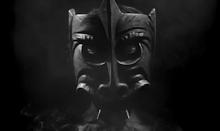
Sugar Hill opens with a frenzied, dynamically edited Voodoo Dance. And just as my brain is cross checking references, comparing it to the voodoo scenes in I Walked With A Zombie and Angel Heart, the camera pulls back and reveals the whole thing to be a put on. A sham, designed to entertain the mostly white patrons of “Club Haiti”.
Welcome to Sugar Hill a movie that is continuously smarter then it needs to be.
The film soon moves into boilerplate blaxsploitation. As the owner of the club is murdered by Mafiosos and his girlfriend swears revenge. Like I said, all standard Blaxsploitation stuff, along with outlandish fashions, a wakka chucka heavy score and ties so large they have their own gravitational pull.
However, to get her revenge she gets goes to her old neighborhood priestess to help her contact Baron Samedi, who raises an army of undead slaves for her, in exchange for her soul.
It is here that the film begins to decidedly diverge from the standard Blaxploitation movie formula.
The encounter with Baron Samedi, and his subsequent raising of the army of the irate dead is genuinely eerie in its matter of factness. The zombies themselves are legitimately creepy, draped in cobwebs, with Ball Bearing Eyes and eager grins, going about the evil deeds of their mistress with enthusiastic relish (And this is despite the fact that they bear an uncanny resemblance to the rasta aliens in Buckaroo Bonzai). That being said, in one of the film’s few major missteps they inexplicably decide to forego The Baron’s uber iconic appearance. ( In all other regards the actor does a fine job. And it's always interesting to see an actor rip into a role when they were given few other chances to do to just that. Given that Don Pedro Colley's other major roles were "Waiter With A Cake" in Herbie Rides Again, "Negro" in Beneath The Planet Of The Apes, and a reoccuring role in the back half of The Dukes Of Hazard I think it's safe to say that he never got to play on quite the same level of joyful malevolence.But imagine a film featuring an encounter with a clean shaven short haired Jesus.)


(A black guy in a top hat)
Unfortunately the actress potrarying Sugar is free of the burden charisma or acting skills, the actor who plays Detective Valentine, her foil, love interest, and provider of powerful filler, is if anything worse, laughably wooden. Like Ed Wood lead wooden. Together they leave a large and rather noticeable hole at the center of Sugar Hill. Though perhaps this is all for the best, had say Pam Grier and Robert Roundtree starred in the film it would have obliterated all need for any other film to ever be made.
Still, Sugar Hill does so much right that it is easy to forgive the things it does wrong. Particularly with the sliding scale that one usually judges exploitation movies. While carefully maintaining the balance of between the contradictory tones of fear in a horror film, and the cathartic nature of a revenge film. Sugar Hill is one of those rare films that manages to have its cake and eat it too. Right down to the way it completely lets it heroine off the hook, despite all the signals it sends that suggest otherwise.
I’ve wanted to see Sugar Hill since its bat shit insane trailer showed up on 42nd Street Forever Volume 2. That trailer made the movie look impossibly fun. But the fact is that most exploitation movies only live up to a mere whiff of their potential.
Sugar Hill belongs to a rarified sub genre. That of the exploitation film that is exactly as much fun as the trailers and posters make it look.












































































































































